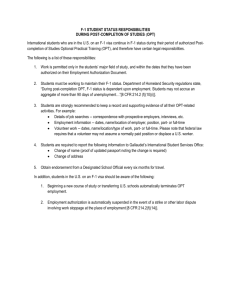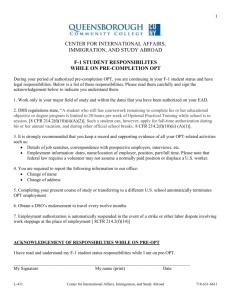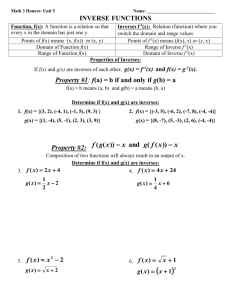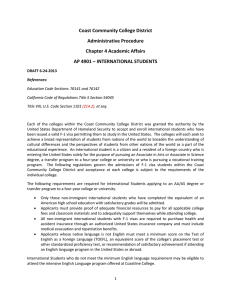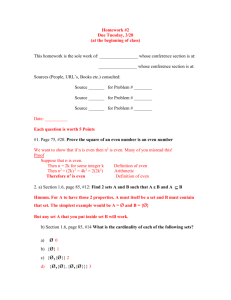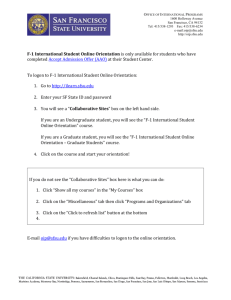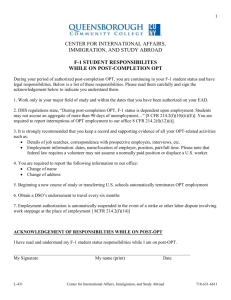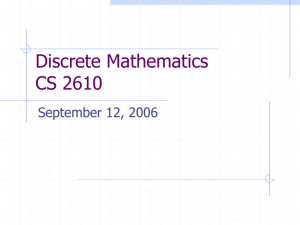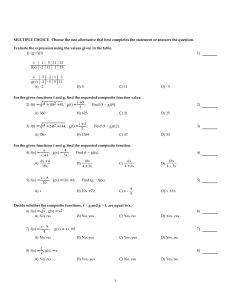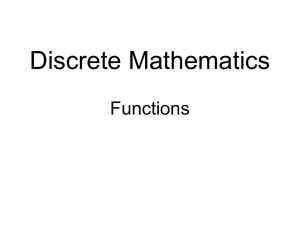Algebra review problems
advertisement
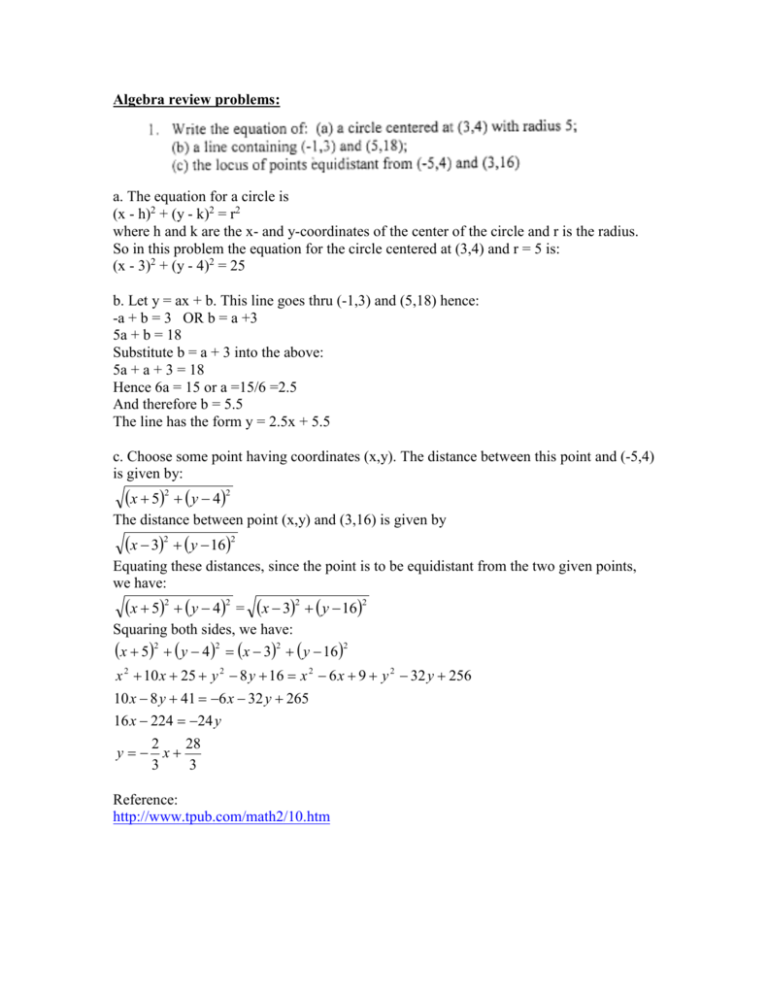
Algebra review problems: a. The equation for a circle is (x - h)2 + (y - k)2 = r2 where h and k are the x- and y-coordinates of the center of the circle and r is the radius. So in this problem the equation for the circle centered at (3,4) and r = 5 is: (x - 3)2 + (y - 4)2 = 25 b. Let y = ax + b. This line goes thru (-1,3) and (5,18) hence: -a + b = 3 OR b = a +3 5a + b = 18 Substitute b = a + 3 into the above: 5a + a + 3 = 18 Hence 6a = 15 or a =15/6 =2.5 And therefore b = 5.5 The line has the form y = 2.5x + 5.5 c. Choose some point having coordinates (x,y). The distance between this point and (-5,4) is given by: x 52 y 42 The distance between point (x,y) and (3,16) is given by x 32 y 162 Equating these distances, since the point is to be equidistant from the two given points, we have: x 52 y 42 = x 32 y 162 Squaring both sides, we have: x 52 y 42 x 32 y 162 x 2 10 x 25 y 2 8 y 16 x 2 6 x 9 y 2 32 y 256 10 x 8 y 41 6 x 32 y 265 16 x 224 24 y 2 28 y x 3 3 Reference: http://www.tpub.com/math2/10.htm Substitute one into the other: x2 x 3 2 1 x 2 3x 2 1 4x 2 1 x2 1 4 1 1 x 4 2 1 y 3 0.87 2 Hence the points of intersection are (0.5,0.87) and (-0.5,-0.87) x 3 y 3 x y x 2 xy y 2 x 2 xy y 2 x y x y x y x2 y2 Reference: http://mathworld.wolfram.com/PolynomialIdentity.html a. b. c. 6 3 6 6 a a 12 2 3 2 3 4 3 6 a 1. Circumference = 2*pi*R =2*3.14*12 = 75.36 l(B,C) = Ra /180 2. The arc length for an angle a is (see reference): l(B,C) = Ra /180 Hence when a = 30, l(A,B) = 6.28 3. l(B,C) = 12*80* /180 = 16.7 4. l(B,C) = 12*120* /180 = 25.12 5. Rearrange: a = l(B,C)*180/(R ) Hence a = 3 *180/(12* ) = 45 (degrees) 6. a = 16 *180/(12* ) = 240 (degrees) Reference: http://math.rice.edu/~pcmi/sphere/drg_txt.html Note that pages 136-137 are not attached in the problem. Page 143, problem 1 Yes the function is periodic. The fundamental period of a function is the length of a smallest continuous portion of the domain over which the function completes a cycle. That is, it's the smallest length of domain that if you took the function over that length and made an infinite number of copies of it, and laid them end to end, you would have the original function. In this case the fundamental period is 6. The amplitude of a periodic function is the distance between the highest point and the lowest point, divided by two. The amplitude is 1 in this case. Note that for a periodic function g(x) with period p, the following is true: f(p*k+a) = f(a) is true for all a real, k integer. So f(1000) = f(166*6+4) = f(4) = -1 Also f(-1000) = f(-167*6+2) = f(2) = 1 Reference: http://library.thinkquest.org/2647/algebra/ftperiod.htm Page 143, problem 3 Period = 3 Amplitude = 0.5 f(1000) = f(333*3+1) = f(1) = 2 Also f(-1000) = f(-334*3+2) = f(2) = 3 Page 143, problem 7: First re-arrange a. y = x 2 b. y = x 3 c. y = x 5 4 d. y = 2 x 1 e. y = x 1 f. y = 2 x 3 All of the graphs were provided in excel file attached. Page 149, problem 1 a. f-1(6) = 2. b. f-1(f(3)) = f-1(7) = 3. c. f(f-1(7)) = f(3) = 7. Reference: http://www.analyzemath.com/inversefunction/inversefunction.html Page 150, problem 11 Here's your original function: y = 3x - 5 y5 Try to solve for "x =": x 3 Switch x and y; "y =" is the inverse. y x5 3 Hence an inverse exists as above. x 5 x 5 We see that f(f-1(x))= f 3 5 x 3 3 3x 5 5 x Also f-1(f(x))= f 1 3x 5 3 Hence f(f-1(x))= f-1(f(x))= x Reference: http://www.purplemath.com/modules/invrsfcn3.htm Page 150, problem 21 The graphs were plotted in Excel Using the above procedure to find a rule for g-1(x) Here's your original function: y = 9 – x2 , x ≤ 0. Try to solve for "x =": x 9 y Switch x and y; "y =" is the inverse. y 9 x Hence g-1(x) = 9 x , x ≤ 9. Page 207, problem 32 8 x 87 x a. x 7 x x 3.5 0 .6 5 x 0 .6 x / 2 5x x / 2 b. 4. 5 x 0 x0 e 3x e x 3x x c. 2x 0 x0 x 1 6 x 2 2 d. 2 x 2 6 x x 6 x 06 This is illegal so the inequality cannot be satisfied with any value of x. Page 162, problem 9 We have the relationship due to geometry: 1. 8 s 3 sd 1.8s 1.8d 3s 1.8d 1.2 s 3 s d 2 a. Area of the base = w2 Cost for the base = 8*w2 Area of the 4 sides = 4*(8/w) = 32/w Cost for sides = 6*32/w = 192/w Hence total cost C = 8w2 + 192/w b. I did this in Excel file. Plot C vs. w (w >0). From graph, cost is minimum when w = 2.3 (m). The cost is about $127 350 300 250 200 C 150 100 50 0 0 1 2 3 4 5 6 7

